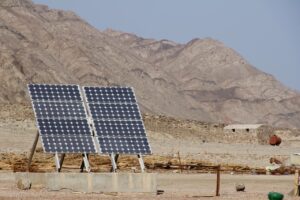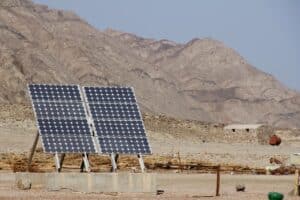Should we start placing more solar farms in deserts?
 7 November 2022
7 November 2022
Increasing the number of solar farms worldwide will significantly contribute to energy independence and carbon-neutral lifestyles. Building them in grassy fields and on rooftops is commonplace. Could the complex problem of streamlined renewable energy be solved with a simple solution like placing solar panels in deserts?
It’s critical to analyze solar panel performance in all environments for their durability and efficacy. This includes experimentation with solar farms in the desert to analyze their performance versus environmental impact. The concentration of sunlight makes them ideal settings for storing vast amounts of energy — but is that simple?
The standard benefits of solar panels potentially increase in a desert climate due to more direct exposure to sunlight. Canopies of frees do not prevent rays from reaching the ground and clouds are less common than in other places. The flatter land is ideal for the easy installation of solar arrays. This is visible by the world’s largest solar farms dominating large stretches of desert.
The sun’s strength in deserts could store enough energy to provide power 24/7, with no interruptions despite the weather or time of day. This includes additional capacity in case generators need energy during an outage or natural disaster.
It could also help the environment by creating economic stability in less developed countries worldwide. Access to solar energy could facilitate more technological advancement, creating job opportunities and improving the health and wellness of citizens.
These opportunities affect the climate by allowing people more freedom to choose their professional path. For instance, they could escape an environmentally damaging sector like fast fashion or mining and venture into sustainability. Nobody would have to resort to fossil fuels because it was the only job available.
Will Panels Harm Native Plants and Animals?
To achieve global climate goals of greenhouse gas reductions, projects related to renewable energy infrastructure will need to be expedited. However, adapting too rapidly in solar farm implementation could prove harmful to resident wildlife. This is especially true since solar panels can emit additional energy, releasing it as heat.

This can damage the surrounding areas or cause the environment to get even hotter. It would also change other weather patterns drastically, like the amount of rain. Altering the environment could have its impacts unless alternative materials can mitigate this side effect, leaving deserts primarily unaffected.
Siting solar panels at more remote areas of deserts is one option that may appeal to conservationists. However, the long-term effects of solar farms in these area have to be explored too as we don’t always have adequate data to make informed decisions about local wildlife.
Solar panel installation may threaten turtles, iguanas and other burrowing animals because we have to dig to ground the panels. This could have a ripple effect by disrupting flora from optimal growth patterns and subsequently affecting insect reproduction. People may be doing environmental harm despite the energy gains, especially if panel installation or bulldozing causes wildlife removal.
However, some suggest solar and wind farms could bring life back to deserts like the Sahara if the climate were to change. The world’s largest desert would be capable of producing the globe’s energy needs multiple times over.
One of the most recent projects to propel desert solar panels is the Crimson Solar Project, a mission to build a photovoltaic facility over 2,000 acres of desert land in California owned by the U.S. Bureau of Land Management. This project, completed in 2021, stores 350 MW of energy.
Initiatives like this benefit the environment and create green jobs, boosting the workforce’s skill set. This will hopefully lead to more positions creating solutions for desert solar panel issues, like the costs and energy consumption of transportation of panels to the desert.
Advancements in solar panels are also making farms in the desert more realistic. This includes improvements to panel durability, including how well they adhere to the sand. Concerns of sandstorms reducing efficiency and debris affecting durability encouraged engineers to experiment with desert climate-friendly innovations.
Engineers added electric fields to the panels to disperse the particles, preparing them for the threats of the climate. This reduces the amount of distilled water used to clean panels, saving it for more beneficial purposes. Internet of Things (IoT) advancements and cloud services are also assisting with issues surrounding remote operations of the panels since it is expensive and resource-intensive to regularly transport people to a desert.
Some of the world’s most successful and vast solar farms already exist in deserts, changing the lives of people in surrounding areas by providing clean energy. Sustainable desert solar panels are possible if we carefully tread around these usually untouched landscapes.
There is progress being made to account for potentially harmful side-effects and with the continued prioritization of greener energies it is likely to pick up even more speed.
The post Should we start placing more solar farms in deserts? appeared first on Sustainability Times.
